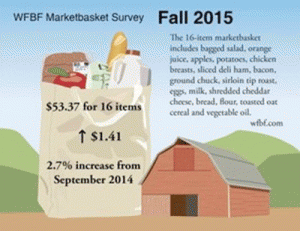from Maudlin Economics,
10/20/15:
My normally super-sweet baby sister barked at me like an angry dog when I told her that there simply isn’t any inflation in the US.
“You need to go to the grocery store with me. You are completely out of touch with reality,” she snapped.
Geez. Excuse me!
My sister, however, should know. She has two boys—one teenager and one college student that still lives at home—with big appetites, so she spends a lot of time and money at her local grocery store.
The topic came up because of the latest Producer Price Index (PPI) numbers from the Labor Department, which said that prices at the wholesale level actually declined by 0.5% in September. Over the last 12 months through September, the PPI has dropped by 1.1%... that’s the eighth consecutive 12-month decrease in the index.
Even if you exclude food and energy—the so-called core prices were down 0.3% in September.
Is my sister crazy? That depends on whether you believe the government’s heavily massaged numbers or people like my sister and farmers.
Here’s what I mean. While the Labor Department was spitting out its PPI numbers, the Wisconsin Farm Bureau Federation (WFBF) begged to differ.
The Wisconsin Farm Bureau Federation tracks the prices of key agricultural commodities that most American households use every day.
Sure, the price of a gallon of milk may be slightly different in Texas than in Wisconsin… but not by that much, and the price trends are usually very similar.
Well, according to the WFBF, the prices of basic grocery staples are rising.

The bureau tracks the cost of 16 widely used food items to come up with its Marketbasket index. The newest semi-annual survey of the 16 items rose to $53.37, up $1.41 or 2.7% compared with one year ago.
Nine of the 16 items surveyed increased in price while six decreased in price compared with WFBF’s 2015 spring survey. One item, apples, was unchanged.

So my baby sister was right!
Moreover, the WFBF doesn’t have an ax to grind when it comes to inflation. It is simply reporting the prices of a static basket of commonly used food items.
My points are that (a) you should always look at government-produced numbers with a skeptical eye, and (b) understand that the government, particularly the Federal Reserve, uses these heavily massaged numbers to justify its agenda.
For example, the lower the cost of living, the less the US government has to pay out in cost-of-living adjustments for Social Security and federal pension recipients.
More From Maudlin Economics:
















